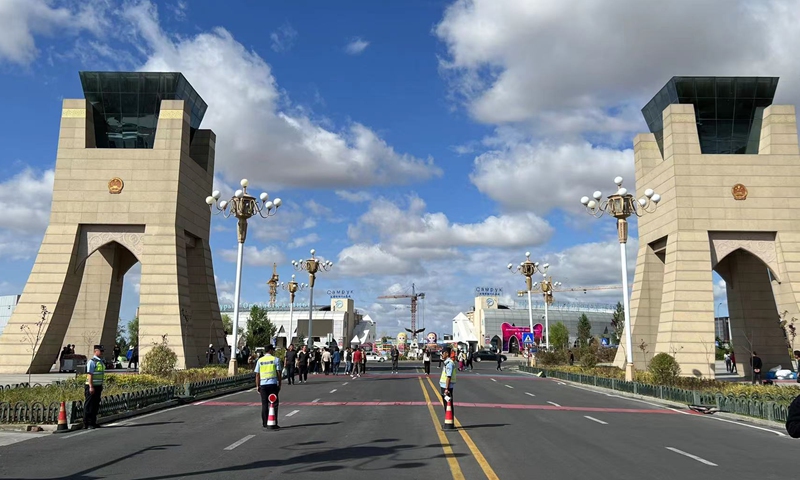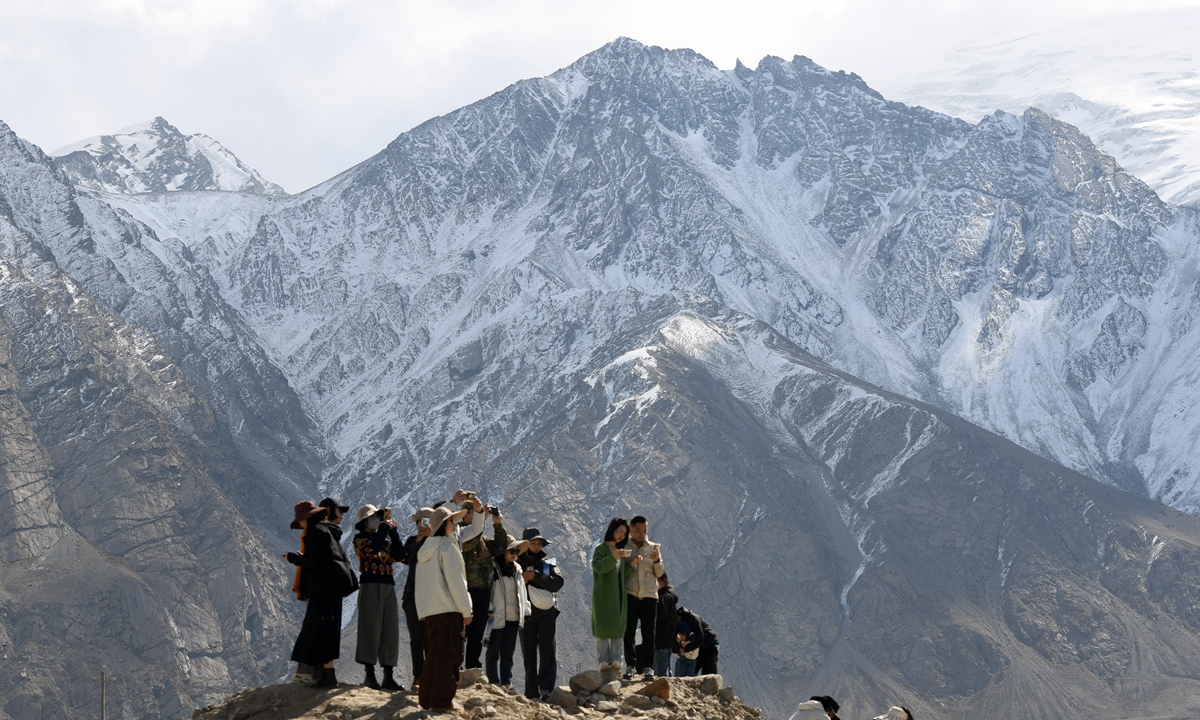A decade of BRI development transforms China's Xinjiang region into a core area of the Silk Road Economic Belt

A view of China- Kazakhstan International Cooperation Center in Horgos, Northwest China's Xinjiang Uygur Autonomous Region on September 16. Photo: Li Xuanmin/GT
On a Sunday morning, workers were harvesting grapes on farmland in Yining county in the Kazak Autonomous Prefecture of Ili, Northwest China's Xinjiang Uygur Autonomous Region. The freshly-picked fruits were then loaded onto a truck, bound for Kazakhstan via highway, and within six hours, it would be delivered to the Kazakh market and sold to locals.
"It used to take two to three days to ship goods from Xinjiang to Kazakhstan, but the time has been reduced to only half a day since the development of the Belt and Road Initiative (BRI), under which connectivity has been facilitated and the efficiency of customs clearance has been largely improved," Yu Chengzhong, chairman of Horgos Jinyi International Trade Co, told the Global Times.
Yu's company is growing quickly thanks to fruit and vegetable exports from Xinjiang which includes apples, nectarines, grapes, peppers, tomatoes, prunes and cucumbers to markets in Central Asia, Russia, and Southeast Asian countries such as Thailand and Vietnam. It is expected that the company's export value to Central Asia could climb up to $1.2 billion this year, almost doubling from $683 million last year.
As business expands, the company is now constructing a 500,000-square-meter overseas warehouse in Alma Ata in southern Kazakhstan, and it is scheduled to be completed in October 2024. "It will be built into a distribution center covering other Central Asian countries and Russia. We will also set up an exhibition area for China-produced vehicles, as those autos have been gaining popularity in those markets," Yu added.
Yu's company is one among the thousands of firms in Xinjiang whose businesses have been taking off under the BRI.
As the China-proposed BRI materialized over the past decade, Xinjiang - which sits at China's westernmost frontier bordering eight countries including Mongolia, Russia, Kazakhstan, Kyrgyzstan, Tajikistan, Afghanistan, Pakistan and India - has been transformed from a relatively closed inland region to a frontier of opening-up and innovation.
As an important node along the BRI, the region, leveraging its strategic location, has built up an overarching rail, road and flight transportation network that not only fosters closer trade and economic ties with Central Asia and Europe, but also shapes itself into a bridgehead for westward opening-up, company representatives and local officials noted.
"What we felt most during the past 10 years is that Xinjiang is no longer a remote region, but it is now becoming a core area of the Silk Road Economic Belt. We're a pivotal international logistic hub placed at the Asia-Europe 'golden passage.' And the region is set to be designated with more important missions in the country's further opening-up," Zhao Yi, assistant to the general manager at the International Land Port in Urumqi, told the Global Times.
Flourishing foreign trade
In the first eight months of 2023, Xinjiang's foreign trade surged by 51.2 percent year-on-year, reaching 219.19 billion yuan (around $30 billion).
Xinjiang has engaged in foreign trade with 170 countries and regions this year. Its foreign trade with five Central Asian countries grew by 59.1 percent year-on-year to 176.64 billion yuan, accounting for 80.6 percent of the region's total export value, customs data showed.
"The main cargoes shipped from Xinjiang to international markets are typically ketchup, agricultural products, textiles, PVC, chemical raw materials, equipment and machinery items," Zhao explained, as he guided the loading of containers into a China-Europe freight train set to depart for Kazakhstan on Sunday afternoon.
As of early September, inbound and outbound China-Europe freight trains in 2023 passing through Xinjiang have totaled 10,017, up 10.1 percent year-on-year, according to China Railway Urumqi Group Co Ltd.
In the first seven months of 2023, the International Land Port in Urumqi welcomed 772 China-Europe freight trains, up 9.35 percent year-on-year. The rail routes connect with 26 cities across 19 countries. The port also serves as an important transit point for goods across China and from Southeast Asia to be transported to Europe.
Ding Zhijun, an official from the Urumqi Economic and Technological Development Zone, told the Global Times that since the beginning of this year, goods from Laos, such as sugar and rubber, have been transferred at the port via the China-Laos Railway and other inland rail links, and then are assembled and delivered to European markets.
"The BRI has driven up Xinjiang's foreign trade, which is a boon for local industries. It is also conducive to Xinjiang's economic development and boosting employment opportunities," Ding said. He added that looking to the future, the port authorities plan to set up a textile trading center within the port, to facilitate the exports and trade of clothes and other textile products.
Wider opening-up
The hustle and bustle of international cooperation in Xinjiang is also seen throughout the China-Kazakhstan International Cooperation Center in Horgos, which is home to China's first cross-border free trade zone. When Global Times reporters visited the center on a mid-September weekend, streams of tourists were standing at the border gate and taking photos, and stores were crowded with merchants and buyers.
"In the initial stage when we set up the shopping mall in 2015, most merchants were from Kazakhstan and China. But now, with the steady progress of BRI, the center has become a hot destination for foreign investment, and there are more vendors from other Central Asia countries as well as Russia and South Korea," Ji Gang, general manager of Jindiao Central Square, a shopping mall at the cooperation center, told the Global Times.
According to Ji, the center held a commercial fair for Central Asian business leaders in August, during which a number of deals were signed, including equipment purchase agreements. Some Chinese and Kazakh companies also reached initial agreement to open factories in Kazakhstan.
"With a unique geographic advantage, Xinjiang has become an important gateway for China to open up to the West. It is worth noting that the radiation effect of the region is not confined to China, but also to Central Asia and Europe, which would in turn provide Xinjiang with more development opportunities," Ji added.
Zhao also said that the International Land Port is planning to open more China-Europe freight train routes that directly connect the region to Europe.
"In particular, we aim to set up some premium routes to transport electronic components and local specialty goods via the China-Europe railway express. This year, we are also actively engaging with Kazakhstan to establish business partnerships and enhance customs clearance efficiency," Zhao noted.



